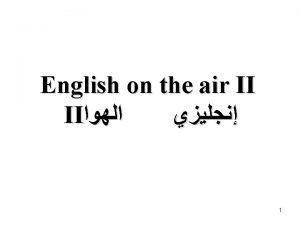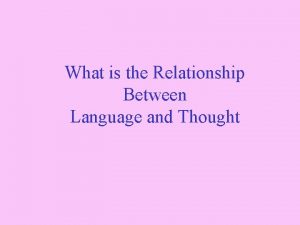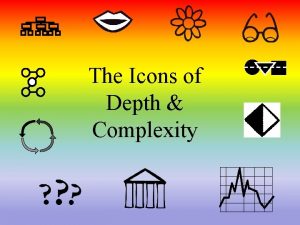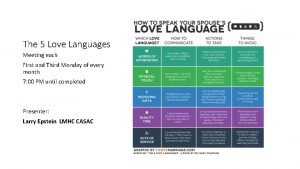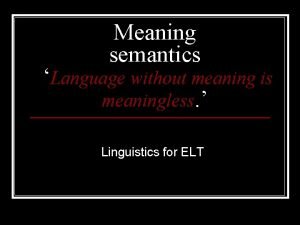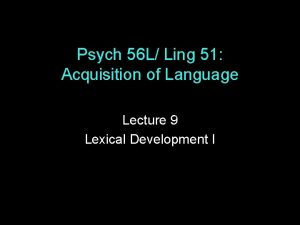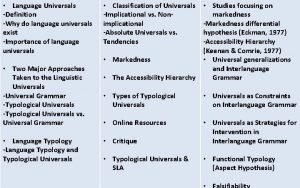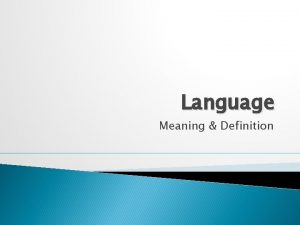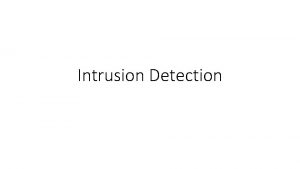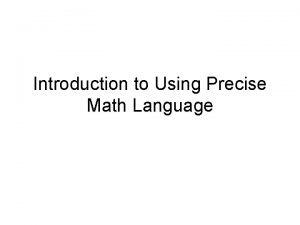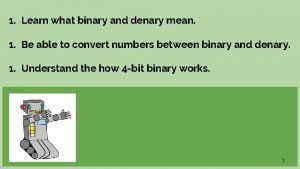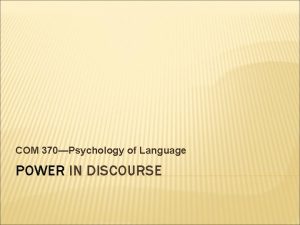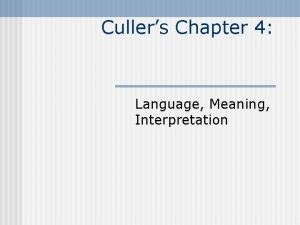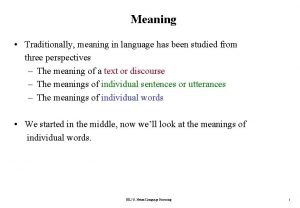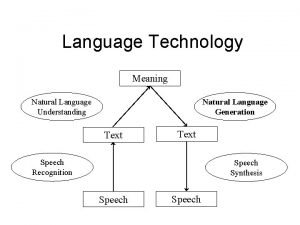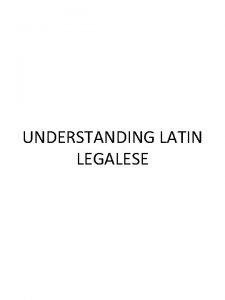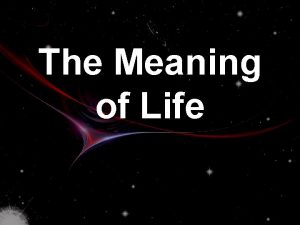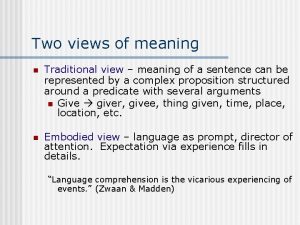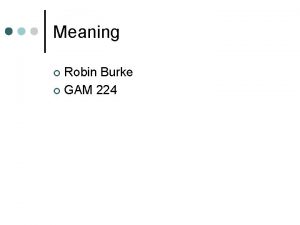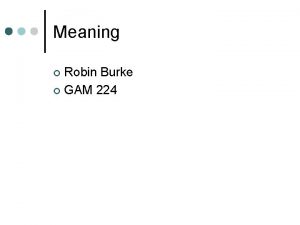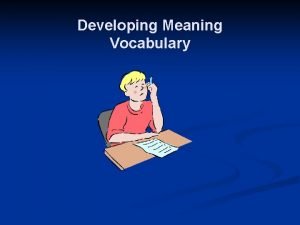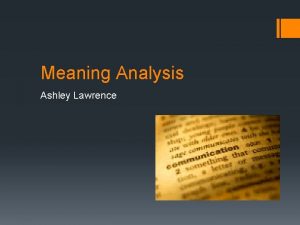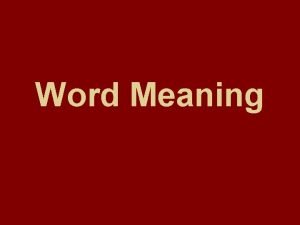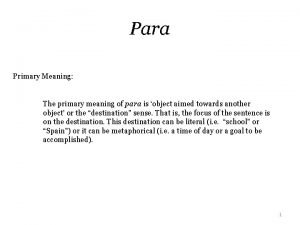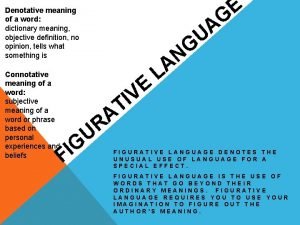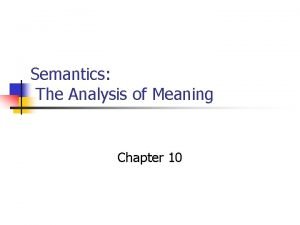Language Meaning COM 370Psychology of Language John R































- Slides: 31

Language & Meaning COM 370—Psychology of Language John R. Baldwin Illinois State University

American & Chinese Communication (Gao & Ting-Toomey, 1998) American Communication Chinese Communication q q q q What is said “I” focus Impolite talk Direct talk Assertive speech Self-enhancing talk Public personal questions q Expressive speech What is not said “We” focus Polite talk Indirect talk Hesitant speech Self-effacing talk Private personal questions q Reticent speech

Levels of Language • • Phonemic: /th/ /r/ /ö/ Morphological: Adam/s/; particles: “ma” Semantic/Lexical: “babe, ” “amigo” Syntactic: Imperfect v. preterite; future subjectunctive • Pragmatic: Asking a Q; persuading • Rhetorical/ideological: Underlying ideas, nature of “communication, ” etc.

Morphological Differences • Greek nouns: http: //abacus. bates. edu/~hwalker/Grammar/gramrev. html • Conjugating verbs: Pick a language: http: //www. logosconjugator. org/owav/verba_dba. verba_main. create_page? lang=en • Check out SIUs South East Language page! http: //www. seasite. niu. edu/ • Tones? : http: //www. edu-cyberpg. com/Music/perfectpitch. html http: //www. youtube. com/watch? v=X 25 l. Ld. Xe. SUo&feature=related http: //www. youtube. com/watch? v=6 nlw 4 NJdn. NE • Clicks? : http: //www. educyberpg. com/Music/perfectpitch. html http: //www. youtube. com/watch? v=D_l 7 ty_MH_Y Some tonal humor… http: //www. youtube. com/watch? v=b 4 g. Kqjd 00 E 4

Lexical Choice • Words of Connection – – Kuan-shi Nunch’I Jeito Palanca • Semantic differences: – Amigo; close friends – Freedom – Term paper • Pragmatic differences: conflict, humor, etc. . .

Basic Concepts • Sapir-Whorf Hypothesis: Language “constructs” or creates our (social) reality http: //pages. slc. edu/~ebj/IM_97/Lecture 14/L 14. html

Stances on Linguistic Relativity Steinfatt, 1989 • • LR-NO: _________ LR-LO: __________ LR-GCS: _________ LR-CA: __________

Basic Concepts • Bernstein Hypothesis: Social situations dictate our language – Restricted Code – Elaborated Code – Code Switching

Evidence for or against linguistic relativity Area of Research Language Development Language comparison (interlanguage) Dialects, etc. (Intralanguage) • deficit explanation • difference explanation Bilingualism Aphasics • Rule of Ribot Deaf languages For? Against?

Ways of doing language research on cultural differences (Goddard & Wierzbicka, 1997) • Ethnography of Communication: _______ • Contrastive pragmatics – Grice – Politeness – Speech Acts, etc. • “Culture” studies (not “cultural studies”) • Cultural scripts approach: – Why do Goddard & Wierzbicka like this approach? – Key words: PEOPLE, SOMEONE, THIS, SAY, THINK, WANT, GOOD, BAD, etc.

Example of a Cultural Script • If something bad happens to someone because of me • I have to say something like this to the person: “I feel something bad because of this. ” Not an apology, because the speaker may or may not be responsible for the bad thing!

Scripts, language forms, & values What are some scripts or language forms for each of the following groups? What underlying values do they suggest? Compare and contrast! How might such differences cause difficulty in intercultural communication, negotiations, public relations or media work, ?

Scripts, language forms, values Form Japanese Malay Polish Yakunytjatjara Ewe Underlying Value

BREAK!

Speech Codes Theory Background Ethnography (Soc/Anth)—Dell Hymes Ethnography of Speaking/Comm Gerry Philipsen (UW) Donal Carbaugh Chuck Braithwaite Mary Jane Collier? Tamar Katriel Bradford “BJ Hall Kristine Fitch Stella Ting-Toomey

Speech Codes theory (Philipsen, Coutu, & Covarrubias, 2005) • Background – Grounded in “observation of communication conduct” (p. 56) – A way to use “situated codes and meanings” to decipher everyday communication conduct – Goal to develop a specific understanding of each culture, with assumption that each culture is unique – Goal to develop a framework that can be used to apply to any culture, even to compare cultures, in regards to a particular speech genre (Philipsen, 1989).

Speech Codes theory (Philipsen, Coutu, & Covarrubias, 2005) • Speech codes: – “a system of socially constructed symbols and meanings, premises, and rules, pertaining to communicitave conduct” (Philipsen, in PCR, p. 57) • Symbolic (situated) resources: – “Symbols and meanings, premises, and rules, pertaining to communicative conduct—that participants use to name, interpret, and judge communicative conduct. ” Resources “to eanct, name, interpret, and judge communicative conduct” (p. 57). That is… • Codes: contingent (not fixed); open (not closed)

Speech Codes Theory Speech codes involve/result/create: • Psychology of culture: meanings • Sociology of culture: social relations • Rhetoric of culture: strategic conduct In sum, – Meaning of messages relies fundamentally on codes – Speech codes are located in language and communication of native speakers – Speech codes can be used to understand, predict, and control communication – Speech codes enact certain identities

Speech Codes Theory The Propositions: 1. Distinctive culture. . Distinctive speech code 2. In any community, multiple speech codes 3. Code distinctive psychology, sociology, rhetoric 4. SCs speakers use determine how important speaking is to give meaning to action 5. Terms, rules, premises of SC are woven into act of speaking itself (metacomm, stories, etc. ) 6. “Artful use of a shared code” creates conditions for “predicting, explaining, and controlling” various aspects of the form of discourse (p. 63)

Speech Codes Theory The “Descriptive Model”: Scene: when, where… Participants: who… Ends: why… Act sequence: what order… Key: feeling Instrumentalities: channel, register Norms: how Genre: what (joke, conversation, leave-taking, requests, instructions…)

Applications of SCT Egyptian & Jewish Comm • Dugri & Musayra (Ellis & Maoz, 2003) – JEWISH ISRAELI: Dugri (Katriel, 1986): • • “Straight talk”: Direct, to the point Assertive Concerned with clarity, efficiency, image of directness In-group code among Western Israeli Jews – ARABIC: Musayra (Feghali, 1997): “Accommodating, going along with”: 4 aspects • Repetition: formulaic, compliments, praise, paralellism • Indirectness: Interpersonal caution • Elaboration: metaphor, exaggeration • Affectiveness: intuitive and emotional style

Applications of SCT Colombian, Colorado & Beyond • Columbia (Fitch, 1994) – Hierarchia: social status – Confianza: trust, connectedness – [cf. “Sal si puede” ritual] • Colorado – Saving negative face

Application: Public “Problem” Talk & Donahue • New York Hardcore: http: //www. youtube. com/watch? v=igfo. Vy. Tnz 0 g • The Dangers of Moshing: http: //www. youtube. com/watch? v=47 TWt 3 vi 9 hc

Face negotiation theory (of conflict) (Ting-Toomey, 2005) • Background: Goffman – Face: “about identity respect and other-identity consideration issues within and beyond the actual encounter episode” (p. 73) – Can be “threatened, enhanced, undermined, and bargained over—on both an emotional reactive level and a cognitive appraisal level” (p. 73) • Brown & Levinson – Positive and negative face – Self and other face – Positive and negative politeness

Face negotiation theory (Ting-Toomey, 2005) • Background: Facework “the specific verbal and nonverbal behaviors that we engage in to maintain or restore face loss and to uphold and honor face gain” • Face loss • FTAs • Preventative and restorative facework

Face negotiation theory (Ting-Toomey, 2005) • Assumptions (summarized) – People in all cultures negotiate face – Some situations especially threaten face – Cultural variable differences influence aspects of face negotiation – Individual differences also influence face

Face negotiation theory (Ting-Toomey, 2005) • Aspects of face that might be influenced: – Face orientation – – (self/other/both) Face movements (defended, saved, maintained, upgraded) Facework interaction strategies (V/NV— direct/indirect) Conflict communication styles Face content domains (positive/negative)

Facework interaction strategies (Ting-Toomey, 2005) • Preventative Facework – Credentialing – Suspended judgment appeals – Pre-disclosure – Pre-apology – Hedging – Disclaimer – … • Restorative Facework – – – – – Direct aggression Excuses Justifications Humor Physical remediation Passive aggressiveness Avoidance Apologies …

Facework Conflict strategies (Ting-Toomey, 2005) Dominating/ Integrating/ Controlling Collaborating Own Goals I Win Compromising I Lose Avoiding/ Withdrawing You Lose Yielding/ Obliging You Win Other’s Goals

Face Content Domains (Ting-Toomey, 2005) • • • Autonomy face Inclusion face Status face Reliability face Competence face Moral face

Lets Make Some (facework) Predictions! • Culture-level variables – Individualism/collectivism – Power distance • Individual-level variables – Self-construal • Independent/dependent • Biconstrual/ambivalent • Relational-contextual variables – In-group/out-group • Other important variables?
 Bài thơ mẹ đi làm từ sáng sớm
Bài thơ mẹ đi làm từ sáng sớm Cơm
Cơm Fused sentence.
Fused sentence. Dear john letter meaning
Dear john letter meaning John 17:20-21 meaning
John 17:20-21 meaning Galatians 2 20 nasb
Galatians 2 20 nasb Lexical and grammatical meaning in semantics
Lexical and grammatical meaning in semantics Literal meaning and implied meaning
Literal meaning and implied meaning Literal language definition
Literal language definition Associative meaning in semantics
Associative meaning in semantics Relation between language and thought
Relation between language and thought Rules depth and complexity icon
Rules depth and complexity icon Love language meaning
Love language meaning Five love languages list
Five love languages list Smthg meaning
Smthg meaning Full statement clauses
Full statement clauses Introduction to english literature
Introduction to english literature Colloquialism meaning and examples
Colloquialism meaning and examples Language meaning
Language meaning Language meaning
Language meaning Language policy
Language policy Language-based approach in teaching literature
Language-based approach in teaching literature Structure meaning imagery language effect
Structure meaning imagery language effect Disadvantages of componential analysis
Disadvantages of componential analysis Language universals
Language universals Ordinary language definition
Ordinary language definition What is intrusion
What is intrusion Precise math language 1st grade examples
Precise math language 1st grade examples What does denary mean in computing
What does denary mean in computing Hemianopic
Hemianopic Definition of standard language
Definition of standard language Language 意味
Language 意味



